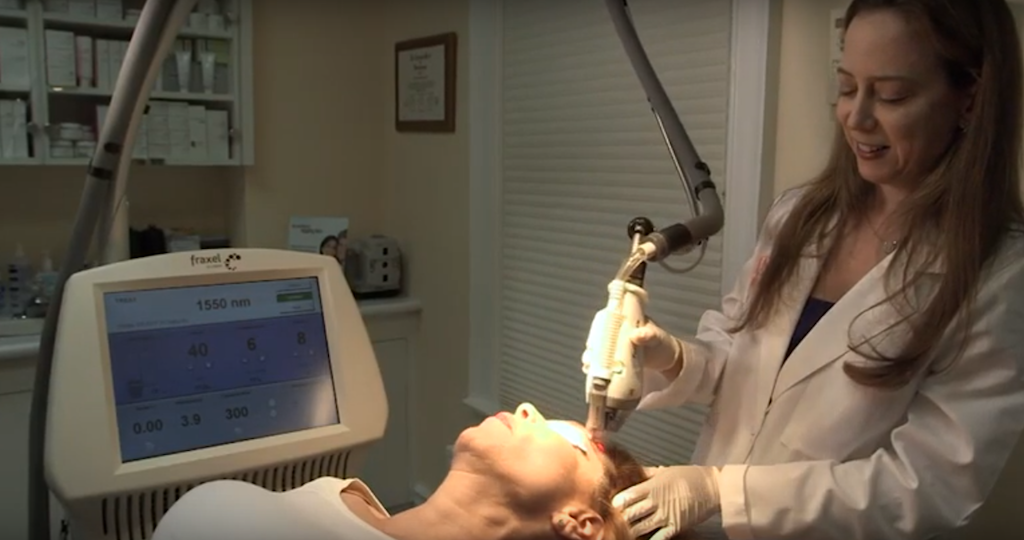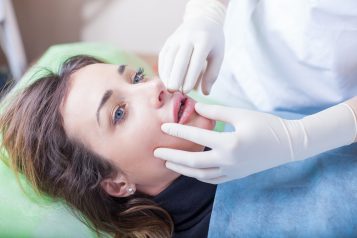
Photo Credit: Dr. Michele Green
Dr. Michele S. Green is a board-certified dermatologist. Upper East Side patients and those from the surrounding areas of New York City flock to her practice for a variety of cosmetic dermatology treatments. A graduate from Yale University, with an MD from Mount Sinai Medical School in NYC, Dr. Green treats some of the most discerning, demanding women and men in the world, with issues ranging from premature skin aging to hyperpigmentation, rosacea, acne, and skin cancer. Dr. Green chats with Haute Beauty about her Fraxel Laser Skin Resurfacing treatment and how it works to treat all of your skin concerns.
HB: What is Fraxel Laser Skin Resurfacing?
Fraxel is the “Magic Eraser” and the gold standard treatment for improving skin tone and texture. Fraxel is an amazing treatment as it has the ability to target so many different skin issues. Fraxel Laser Skin Resurfacing is an FDA-approved fractional laser technology which helps restore the skin to its original, perfect texture and achieves smoother, fresher, younger-looking skin, improved tone and texture, smaller pores, erasing unwanted brown spots, acne scars, hyperpigmentation and surgical scars, and reduces fine lines and wrinkles.
Fraxel uses fractional laser technology that utilizes a scanning device to apply highly concentrated tiny laser pulses to your skin and create thousands of microscopic wounds. Fraxel is used to improve tone, texture and radiance of aging skin. It also helps with the rejuvenation of sun-damaged or scarred skin. It’s termed “fractional” because only a fraction of the skin is treated in a single session. As the skin heals and repairs itself it creates new collagen repairing the skin from the inside out.
HB: How does the Fraxel laser work?
Fraxel is the original fractional laser treatment that works below the skin’s surface from the top-down, addressing imperfections like fine lines, visible photo aging, wrinkles, scarring and age spots. Fraxel light energy stimulates your skin’s natural collagen, rejuvenating skin cells below the surface to help smooth the creases and pockets that cause wrinkles and scars. Fraxel only treats targeted problem areas – so the results are focused and effective.
Fraxel Re:store Dual, is the most common Fraxel laser as it offers a combination of non-ablative and ablative treatments. Fraxel Dual is essentially two lasers in one what this means the laser has two different settings which can be used to address different skin concerns. The 1927nm wavelength allows us to treat superficially (improving pigmentation) while the other, the 1550nm wavelength, targets skin texture (improving deep lines and acne scars). The components can be used together or separately, depending on your needs. This non-invasive procedure is performed as a series of treatments, typically around 1-3 treatments depending upon your desired results.
Fraxel Re:pair this is the most powerful Fraxel laser. It’s ablative, which means it will disrupt the skin surface. This laser is used to treat severe acne scarring, deep wrinkles and extensive sun damage. The skin will require more downtime to recover as the skin can become raw as the laser removes layers of surface tissue.
The procedure will be performed as follows: topical anesthesia (numbing cream) will be applied and stay on for approximately one hour. The topical anesthesia will be removed immediately prior to the procedure. Your eyes will be covered to protect them from the laser beam. As the laser handpiece glides over your skin, the laser will discharge hundreds of tiny pulses that will feel like rubber bands snapping against your skin. Cold air will blow onto your skin to help minimize any discomfort. The actual treatment will take between 15 and 30 minutes depending on the size and location of the treatment area.
The results of Fraxel treatment is both immediate and progressive. Soon after the treatment the surface of your skin will feel softer, smoother, look brighter and show a more even skin tone. The next 3 to 6 months will bring more improvement as the deeper layers of the skin continue to create new collagen.
 Photo Credit: Shutterstock
Photo Credit: Shutterstock
HB: Who is the best candidate for this procedure?
An ideal candidate for Fraxel laser treatment is someone that has signs of premature aging, hyperpigmentation, sun damage, enlarged pores, skin discolorations, mild to moderate periorbital wrinkles, and acne scars. Patients with Melasma, and patients with dark skin tone or olive skin tones should not do Fraxel.
HB: How does this treatment differ to others of the same nature?
Fraxel and Intense Pulse Light (IPL) are able to treat skin concerns regarding sun damage and hyperpigmentation, however, there are some differences between the two. IPL will best treat skin that has pigment changes due to sun damage or hyperpigmentation. It can also treat superficial blood vessels, symptoms of rosacea and flushing. IPL can also reduce large pores, fine lines and wrinkles, and can improve the overall texture of your skin. Fraxel has the ability to take years off your appearance. The Fraxel has FDA clearance to treat many conditions such as: age spots/sun spots, acne, and surgical scars, hyperpigmentation and sun damage.
Deciding whether IPL or Fraxel is the right treatment all depends on your skin concerns. IPL is a great choice if your only concerns are redness, superficial dark spots. Fraxel is a better option if your concerns are overall anti-aging, acne scars or surgical scars and also sun damage, fine lines and wrinkles.
In a nutshell, both Fraxel Laser and IPL are excellent. For immediate results, Fraxel works best and requires fewer treatments as one Fraxel treatment is equivalent to 5-6 IPL treatments. IPL is best for patients who do not want any downtime.
HB: What does recovery look like?
Immediately after the treatment you will feel a sunburn sensation that will disappear in 2-3 hours. Redness and swelling are the most common side- effects. Most of the redness and swelling will go away over the first 1 to 2 days after treatment. The remaining redness will gradually disappear over the next 5-7 days. Immediately after the treatment patient should expect some redness and swelling in the treated area. You will feel a sunburn sensation that will disappear in 2-3 hours. If the patient was treated with the setting 1550, the patient can expect redness and swelling for 2-3 days after the treatment. If the patient was treated with the setting 1927, the patient can expect redness and swelling on days 1 and 2. Days 3 and 4, the patient’s skin will look and feel almost like sandpaper. Peeling and flaking, are also common and will resolve over 5-7 days. Sun avoidance/sun protection is essential after a laser resurfacing procedure, both to protect the skin and prolong the results. Be sure to use moisturizer daily if you experience dryness.
For more information, visit Dr. Brian A. Levine's social media:

























